warning JEEP RENEGADE 2018 Owner handbook (in English)
[x] Cancel search | Manufacturer: JEEP, Model Year: 2018, Model line: RENEGADE, Model: JEEP RENEGADE 2018Pages: 356, PDF Size: 6.11 MB
Page 106 of 356
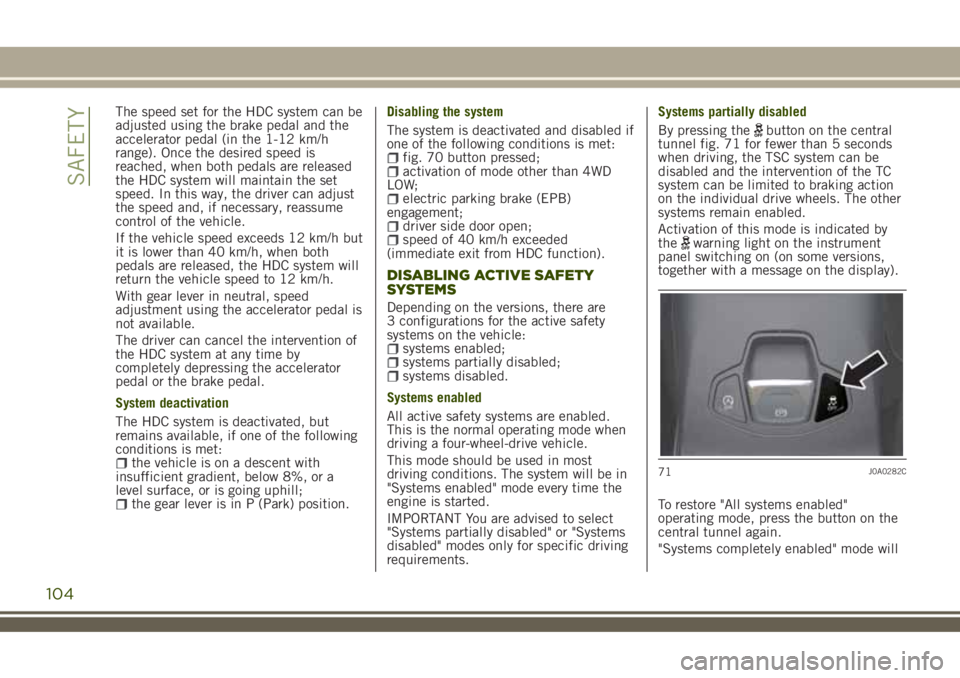
The speed set for the HDC system can be
adjusted using the brake pedal and the
accelerator pedal (in the 1-12 km/h
range). Once the desired speed is
reached, when both pedals are released
the HDC system will maintain the set
speed. In this way, the driver can adjust
the speed and, if necessary, reassume
control of the vehicle.
If the vehicle speed exceeds 12 km/h but
it is lower than 40 km/h, when both
pedals are released, the HDC system will
return the vehicle speed to 12 km/h.
With gear lever in neutral, speed
adjustment using the accelerator pedal is
not available.
The driver can cancel the intervention of
the HDC system at any time by
completely depressing the accelerator
pedal or the brake pedal.
System deactivation
The HDC system is deactivated, but
remains available, if one of the following
conditions is met:
the vehicle is on a descent with
insufficient gradient, below 8%, or a
level surface, or is going uphill;
the gear lever is in P (Park) position.Disabling the system
The system is deactivated and disabled if
one of the following conditions is met:
fig. 70 button pressed;activation of mode other than 4WD
LOW;
electric parking brake (EPB)
engagement;
driver side door open;speed of 40 km/h exceeded
(immediate exit from HDC function).
DISABLING ACTIVE SAFETY
SYSTEMS
Depending on the versions, there are
3 configurations for the active safety
systems on the vehicle:
systems enabled;systems partially disabled;systems disabled.
Systems enabled
All active safety systems are enabled.
This is the normal operating mode when
driving a four-wheel-drive vehicle.
This mode should be used in most
driving conditions. The system will be in
"Systems enabled" mode every time the
engine is started.
IMPORTANT You are advised to select
"Systems partially disabled" or "Systems
disabled" modes only for specific driving
requirements.Systems partially disabled
By pressing the
button on the central
tunnel fig. 71 for fewer than 5 seconds
when driving, the TSC system can be
disabled and the intervention of the TC
system can be limited to braking action
on the individual drive wheels. The other
systems remain enabled.
Activation of this mode is indicated by
the
warning light on the instrument
panel switching on (on some versions,
together with a message on the display).
To restore "All systems enabled"
operating mode, press the button on the
central tunnel again.
"Systems completely enabled" mode will
71J0A0282C
104
SAFETY
Page 107 of 356
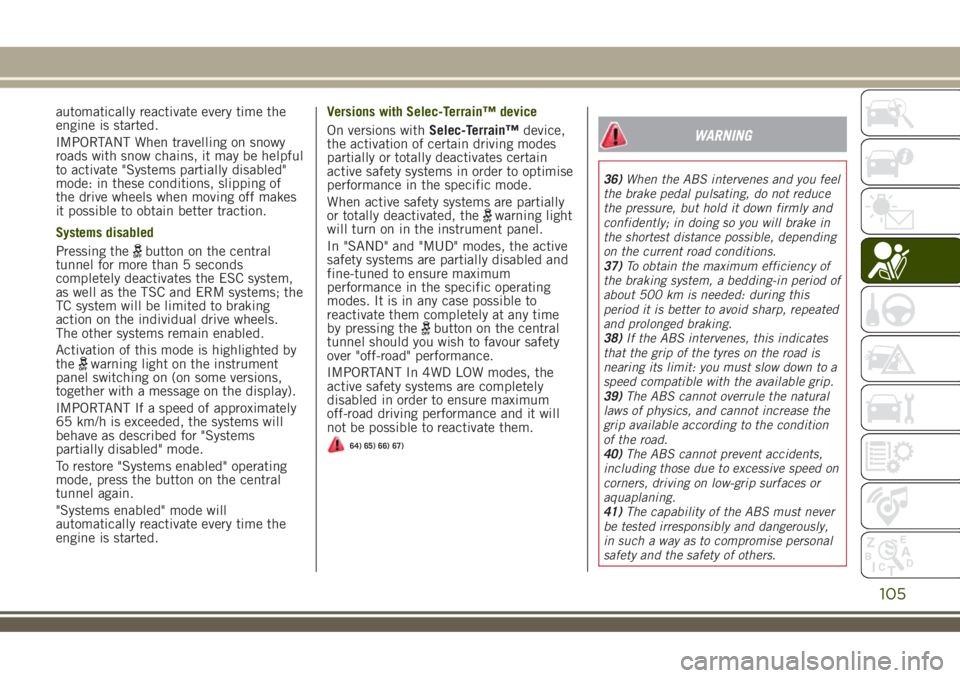
automatically reactivate every time the
engine is started.
IMPORTANT When travelling on snowy
roads with snow chains, it may be helpful
to activate "Systems partially disabled"
mode: in these conditions, slipping of
the drive wheels when moving off makes
it possible to obtain better traction.
Systems disabled
Pressing the
button on the central
tunnel for more than 5 seconds
completely deactivates the ESC system,
as well as the TSC and ERM systems; the
TC system will be limited to braking
action on the individual drive wheels.
The other systems remain enabled.
Activation of this mode is highlighted by
the
warning light on the instrument
panel switching on (on some versions,
together with a message on the display).
IMPORTANT If a speed of approximately
65 km/h is exceeded, the systems will
behave as described for "Systems
partially disabled" mode.
To restore "Systems enabled" operating
mode, press the button on the central
tunnel again.
"Systems enabled" mode will
automatically reactivate every time the
engine is started.Versions with Selec-Terrain™ device
On versions withSelec-Terrain™device,
the activation of certain driving modes
partially or totally deactivates certain
active safety systems in order to optimise
performance in the specific mode.
When active safety systems are partially
or totally deactivated, the
warning light
will turn on in the instrument panel.
In "SAND" and "MUD" modes, the active
safety systems are partially disabled and
fine-tuned to ensure maximum
performance in the specific operating
modes. It is in any case possible to
reactivate them completely at any time
by pressing the
button on the central
tunnel should you wish to favour safety
over "off-road" performance.
IMPORTANT In 4WD LOW modes, the
active safety systems are completely
disabled in order to ensure maximum
off-road driving performance and it will
not be possible to reactivate them.
64) 65) 66) 67)
WARNING
36)When the ABS intervenes and you feel
the brake pedal pulsating, do not reduce
the pressure, but hold it down firmly and
confidently; in doing so you will brake in
the shortest distance possible, depending
on the current road conditions.
37)To obtain the maximum efficiency of
the braking system, a bedding-in period of
about 500 km is needed: during this
period it is better to avoid sharp, repeated
and prolonged braking.
38)If the ABS intervenes, this indicates
that the grip of the tyres on the road is
nearing its limit: you must slow down to a
speed compatible with the available grip.
39)The ABS cannot overrule the natural
laws of physics, and cannot increase the
grip available according to the condition
of the road.
40)The ABS cannot prevent accidents,
including those due to excessive speed on
corners, driving on low-grip surfaces or
aquaplaning.
41)The capability of the ABS must never
be tested irresponsibly and dangerously,
in such a way as to compromise personal
safety and the safety of others.
105
Page 109 of 356

60)When towing trailers, the utmost
caution at the wheel is recommended.
Never exceed the maximum permitted
loads (see the description in the "Weights"
paragraph in the "Technical
Specifications" chapter).
61)The TSC system cannot prevent
swerving for all trailers. If the system
activates during driving, reduce the speed,
stop the vehicle in a safe place and
arrange the load correctly to prevent the
trailer from swerving.
62)Prolonged use of the system may
overheat the braking system. If the brakes
overheat, the HDC system, when active,
will be gradually deactivated after suitably
informing the driver (LED on button off): it
can be reactivated only when the brakes
have cooled sufficiently. The distance that
can be covered depends on the
temperature of the brakes and therefore
on the gradient, load and speed of the
vehicle.
63)The performance of a vehicle with
HDC must never be tested in imprudent or
dangerous ways, with the possibility of
putting the safety of the driver or other
people at risk.64)When "Systems partially disabled"
mode is selected, the intervention of the
TC function is limited to braking action on
the individual drive wheels and the
warning light switches on in the
instrument panel. In "systems partially
disabled" mode, the engine torque value
that the ESC system may require will not
be guaranteed and the stability of the
vehicle will therefore be reduced.
65)With "Systems partially disabled"
mode selected, the TSC (Trailer Sway
Control) system is disabled.
66)Your driving style must always be
suited to the road conditions, visibility and
traffic. The driver is, in any case,
responsible for safe driving.
67)When "Systems disabled" mode is
selected, the ESC system will not be
available in the event of emergency
manoeuvres. "Systems disabled" mode is
only for off-road use.
107
Page 110 of 356
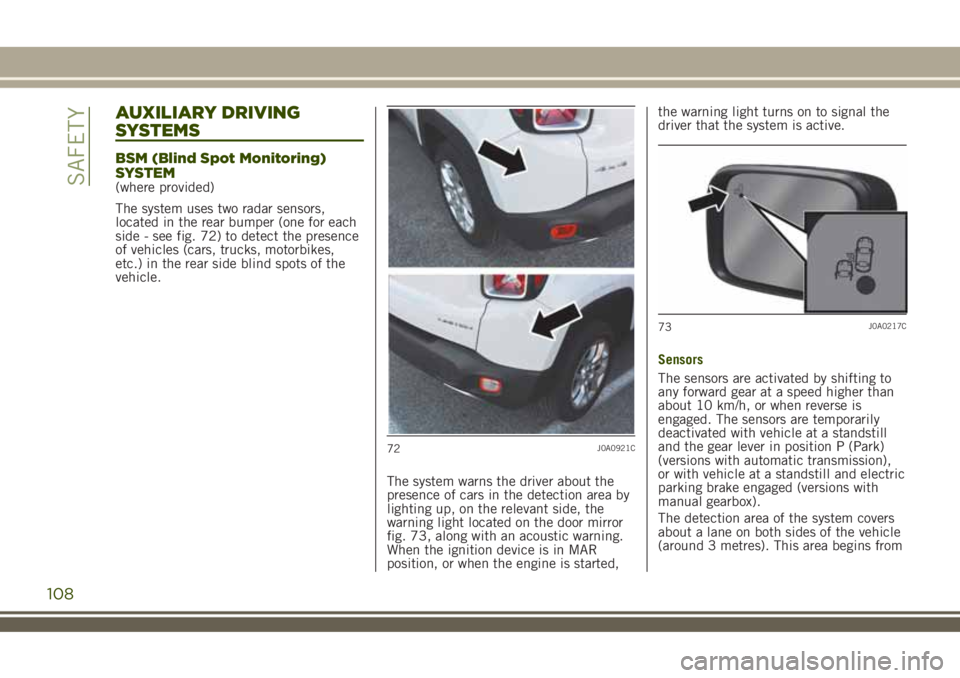
AUXILIARY DRIVING
SYSTEMS
BSM (Blind Spot Monitoring)
SYSTEM
(where provided)
The system uses two radar sensors,
located in the rear bumper (one for each
side - see fig. 72) to detect the presence
of vehicles (cars, trucks, motorbikes,
etc.) in the rear side blind spots of the
vehicle.
The system warns the driver about the
presence of cars in the detection area by
lighting up, on the relevant side, the
warning light located on the door mirror
fig. 73, along with an acoustic warning.
When the ignition device is in MAR
position, or when the engine is started,the warning light turns on to signal the
driver that the system is active.
Sensors
The sensors are activated by shifting to
any forward gear at a speed higher than
about 10 km/h, or when reverse is
engaged. The sensors are temporarily
deactivated with vehicle at a standstill
and the gear lever in position P (Park)
(versions with automatic transmission),
or with vehicle at a standstill and electric
parking brake engaged (versions with
manual gearbox).
The detection area of the system covers
about a lane on both sides of the vehicle
(around 3 metres). This area begins from
72J0A0921C
73J0A0217C
108
SAFETY
Page 111 of 356
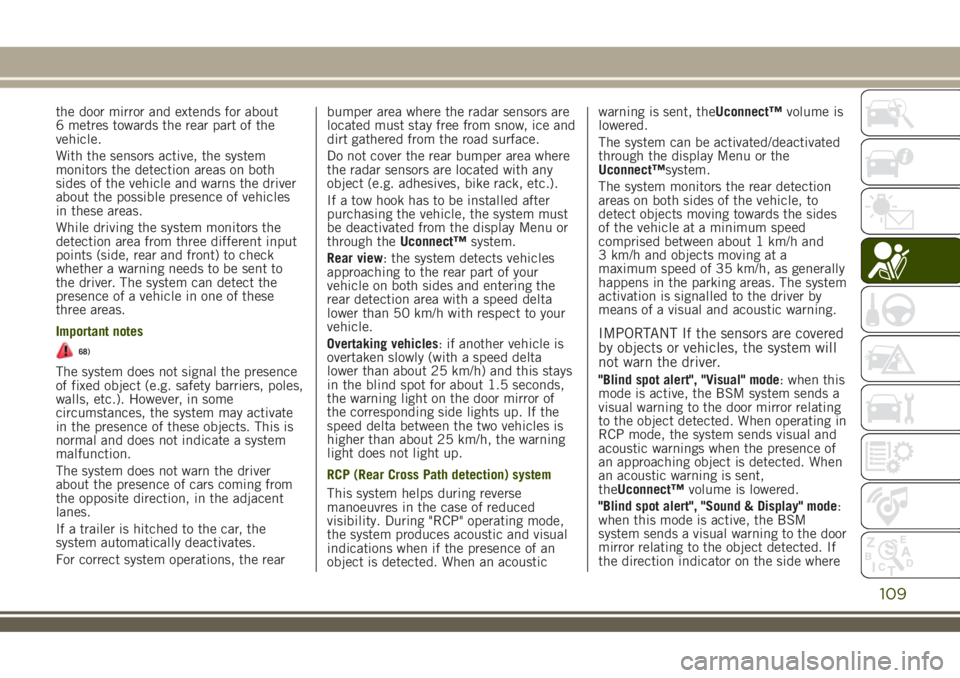
the door mirror and extends for about
6 metres towards the rear part of the
vehicle.
With the sensors active, the system
monitors the detection areas on both
sides of the vehicle and warns the driver
about the possible presence of vehicles
in these areas.
While driving the system monitors the
detection area from three different input
points (side, rear and front) to check
whether a warning needs to be sent to
the driver. The system can detect the
presence of a vehicle in one of these
three areas.
Important notes
68)
The system does not signal the presence
of fixed object (e.g. safety barriers, poles,
walls, etc.). However, in some
circumstances, the system may activate
in the presence of these objects. This is
normal and does not indicate a system
malfunction.
The system does not warn the driver
about the presence of cars coming from
the opposite direction, in the adjacent
lanes.
If a trailer is hitched to the car, the
system automatically deactivates.
For correct system operations, the rearbumper area where the radar sensors are
located must stay free from snow, ice and
dirt gathered from the road surface.
Do not cover the rear bumper area where
the radar sensors are located with any
object (e.g. adhesives, bike rack, etc.).
If a tow hook has to be installed after
purchasing the vehicle, the system must
be deactivated from the display Menu or
through theUconnect™system.
Rear view: the system detects vehicles
approaching to the rear part of your
vehicle on both sides and entering the
rear detection area with a speed delta
lower than 50 km/h with respect to your
vehicle.
Overtaking vehicles: if another vehicle is
overtaken slowly (with a speed delta
lower than about 25 km/h) and this stays
in the blind spot for about 1.5 seconds,
the warning light on the door mirror of
the corresponding side lights up. If the
speed delta between the two vehicles is
higher than about 25 km/h, the warning
light does not light up.
RCP (Rear Cross Path detection) system
This system helps during reverse
manoeuvres in the case of reduced
visibility. During "RCP" operating mode,
the system produces acoustic and visual
indications when if the presence of an
object is detected. When an acousticwarning is sent, theUconnect™volume is
lowered.
The system can be activated/deactivated
through the display Menu or the
Uconnect™system.
The system monitors the rear detection
areas on both sides of the vehicle, to
detect objects moving towards the sides
of the vehicle at a minimum speed
comprised between about 1 km/h and
3 km/h and objects moving at a
maximum speed of 35 km/h, as generally
happens in the parking areas. The system
activation is signalled to the driver by
means of a visual and acoustic warning.
IMPORTANT If the sensors are covered
by objects or vehicles, the system will
not warn the driver.
"Blind spot alert", "Visual" mode: when this
mode is active, the BSM system sends a
visual warning to the door mirror relating
to the object detected. When operating in
RCP mode, the system sends visual and
acoustic warnings when the presence of
an approaching object is detected. When
an acoustic warning is sent,
theUconnect™volume is lowered.
"Blind spot alert", "Sound & Display" mode:
when this mode is active, the BSM
system sends a visual warning to the door
mirror relating to the object detected. If
the direction indicator on the side where
109
Page 112 of 356
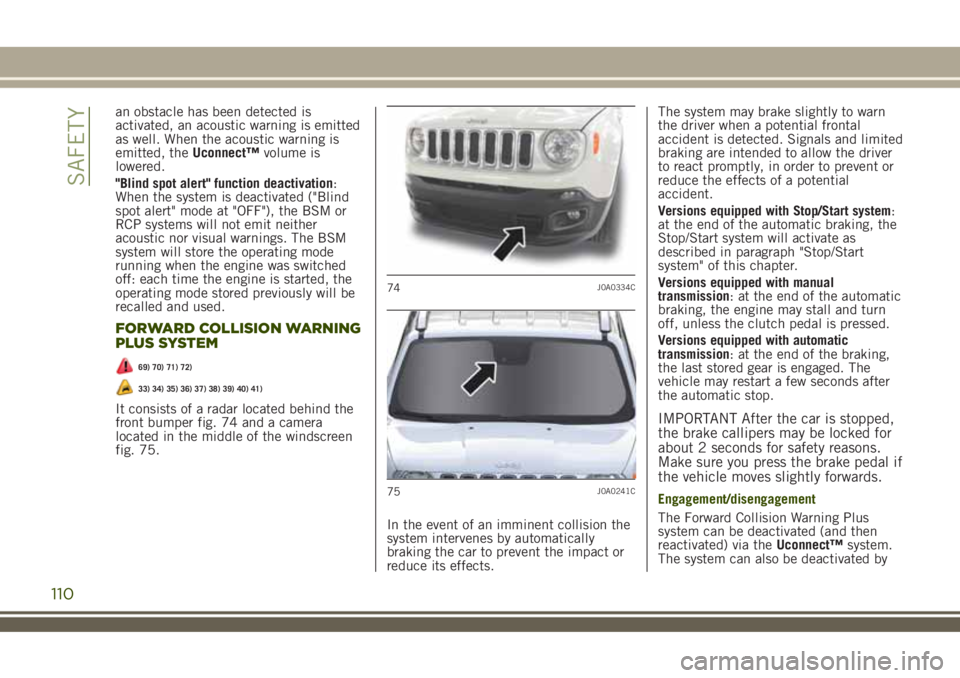
an obstacle has been detected is
activated, an acoustic warning is emitted
as well. When the acoustic warning is
emitted, theUconnect™volume is
lowered.
"Blind spot alert" function deactivation:
When the system is deactivated ("Blind
spot alert" mode at "OFF"), the BSM or
RCP systems will not emit neither
acoustic nor visual warnings. The BSM
system will store the operating mode
running when the engine was switched
off: each time the engine is started, the
operating mode stored previously will be
recalled and used.
FORWARD COLLISION WARNING
PLUS SYSTEM
69) 70) 71) 72)
33) 34) 35) 36) 37) 38) 39) 40) 41)
It consists of a radar located behind the
front bumper fig. 74 and a camera
located in the middle of the windscreen
fig. 75.
In the event of an imminent collision the
system intervenes by automatically
braking the car to prevent the impact or
reduce its effects.The system may brake slightly to warn
the driver when a potential frontal
accident is detected. Signals and limited
braking are intended to allow the driver
to react promptly, in order to prevent or
reduce the effects of a potential
accident.
Versions equipped with Stop/Start system:
at the end of the automatic braking, the
Stop/Start system will activate as
described in paragraph "Stop/Start
system" of this chapter.
Versions equipped with manual
transmission: at the end of the automatic
braking, the engine may stall and turn
off, unless the clutch pedal is pressed.
Versions equipped with automatic
transmission: at the end of the braking,
the last stored gear is engaged. The
vehicle may restart a few seconds after
the automatic stop.IMPORTANT After the car is stopped,
the brake callipers may be locked for
about 2 seconds for safety reasons.
Make sure you press the brake pedal if
the vehicle moves slightly forwards.
Engagement/disengagement
The Forward Collision Warning Plus
system can be deactivated (and then
reactivated) via theUconnect™system.
The system can also be deactivated by
74J0A0334C
75J0A0241C
110
SAFETY
Page 113 of 356
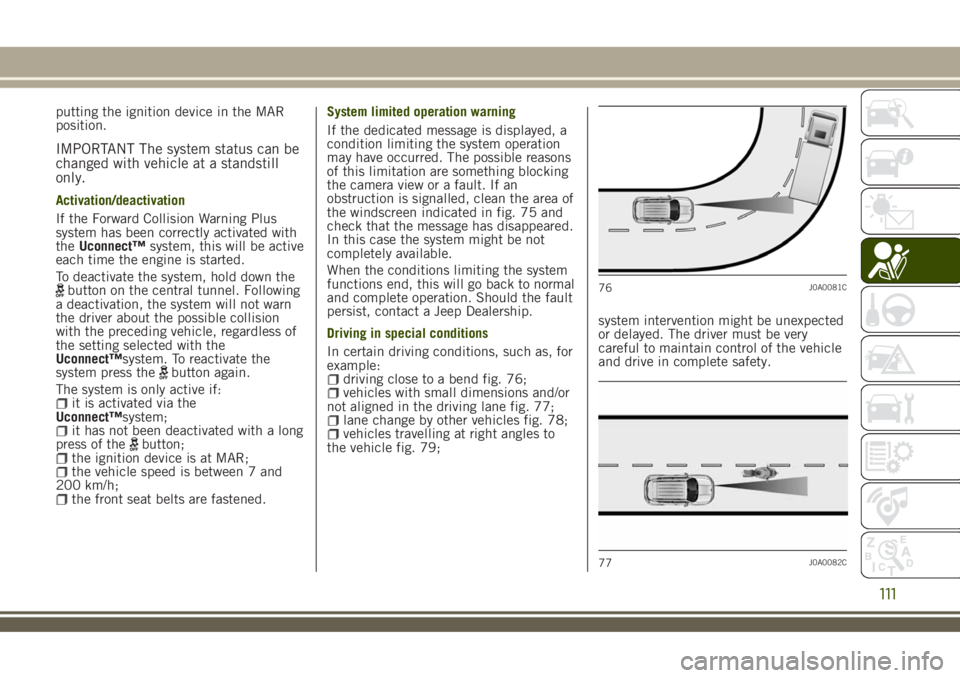
putting the ignition device in the MAR
position.
IMPORTANT The system status can be
changed with vehicle at a standstill
only.
Activation/deactivation
If the Forward Collision Warning Plus
system has been correctly activated with
theUconnect™system, this will be active
each time the engine is started.
To deactivate the system, hold down the
button on the central tunnel. Following
a deactivation, the system will not warn
the driver about the possible collision
with the preceding vehicle, regardless of
the setting selected with the
Uconnect™system. To reactivate the
system press the
button again.
The system is only active if:
it is activated via the
Uconnect™system;
it has not been deactivated with a long
press of thebutton;the ignition device is at MAR;the vehicle speed is between 7 and
200 km/h;
the front seat belts are fastened.System limited operation warning
If the dedicated message is displayed, a
condition limiting the system operation
may have occurred. The possible reasons
of this limitation are something blocking
the camera view or a fault. If an
obstruction is signalled, clean the area of
the windscreen indicated in fig. 75 and
check that the message has disappeared.
In this case the system might be not
completely available.
When the conditions limiting the system
functions end, this will go back to normal
and complete operation. Should the fault
persist, contact a Jeep Dealership.
Driving in special conditions
In certain driving conditions, such as, for
example:
driving close to a bend fig. 76;vehicles with small dimensions and/or
not aligned in the driving lane fig. 77;
lane change by other vehicles fig. 78;vehicles travelling at right angles to
the vehicle fig. 79;system intervention might be unexpected
or delayed. The driver must be very
careful to maintain control of the vehicle
and drive in complete safety.
76J0A0081C
77J0A0082C
111
Page 114 of 356
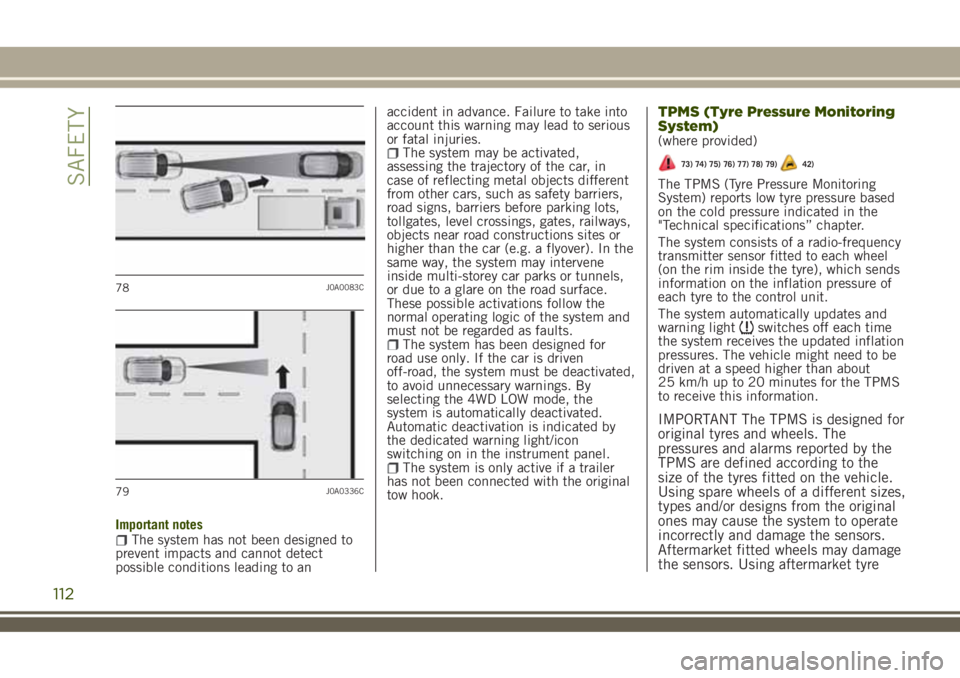
Important notesThe system has not been designed to
prevent impacts and cannot detect
possible conditions leading to anaccident in advance. Failure to take into
account this warning may lead to serious
or fatal injuries.
The system may be activated,
assessing the trajectory of the car, in
case of reflecting metal objects different
from other cars, such as safety barriers,
road signs, barriers before parking lots,
tollgates, level crossings, gates, railways,
objects near road constructions sites or
higher than the car (e.g. a flyover). In the
same way, the system may intervene
inside multi-storey car parks or tunnels,
or due to a glare on the road surface.
These possible activations follow the
normal operating logic of the system and
must not be regarded as faults.
The system has been designed for
road use only. If the car is driven
off-road, the system must be deactivated,
to avoid unnecessary warnings. By
selecting the 4WD LOW mode, the
system is automatically deactivated.
Automatic deactivation is indicated by
the dedicated warning light/icon
switching on in the instrument panel.
The system is only active if a trailer
has not been connected with the original
tow hook.
TPMS (Tyre Pressure Monitoring
System)
(where provided)
73) 74) 75) 76) 77) 78) 79)42)
The TPMS (Tyre Pressure Monitoring
System) reports low tyre pressure based
on the cold pressure indicated in the
"Technical specifications” chapter.
The system consists of a radio-frequency
transmitter sensor fitted to each wheel
(on the rim inside the tyre), which sends
information on the inflation pressure of
each tyre to the control unit.
The system automatically updates and
warning light
switches off each time
the system receives the updated inflation
pressures. The vehicle might need to be
driven at a speed higher than about
25 km/h up to 20 minutes for the TPMS
to receive this information.
IMPORTANT The TPMS is designed for
original tyres and wheels. The
pressures and alarms reported by the
TPMS are defined according to the
size of the tyres fitted on the vehicle.
Using spare wheels of a different sizes,
types and/or designs from the original
ones may cause the system to operate
incorrectly and damage the sensors.
Aftermarket fitted wheels may damage
the sensors. Using aftermarket tyre
78J0A0083C
79J0A0336C
112
SAFETY
Page 115 of 356

sealants may damage the Tyre Pressure
Monitoring System sensor. If
aftermarket tyre sealant has been
used, it is recommended to go to a
Jeep Dealership to have the sensors
checked. After checking or adjusting
the tyre pressure, always refit the valve
cap to prevent humidity and dirt from
entering. They could damage the Tyre
Pressure Monitoring System sensor.
NOTE Some external factors (e.g.
external temperature, etc...) could affect
the information reported on the
instrument panel by the TPMS.
The tyre inflation pressure and the “low
pressure” reporting threshold could
change depending on the environmental
conditions.
TPMS check message
If a system failure is present, the
warning light flashes for about
75 seconds and then stays on solid. An
acoustic signal is also emitted.
TPMS deactivation
The TPMS can be deactivated by
replacing the wheels equipped with
TPMS with others that are not (e.g. when
replacing the wheel assemblies in
winter), if the country of purchase allows
it. Then drive the vehicle for at least
20 minutes at a speed higher than about25 km/h. The TPMS will emit an
acoustic warning, the
warning light
will flash for about 75 seconds, then will
stay on constantly and the instrument
panel will display the "Tyre pressure not
available" message with some dashes (–
–) instead of the pressure values.
The next time the engine is started, the
system will not emit any acoustic signal
and the display will not show the
message "Tyre pressure not available",
but the dashes (– –) will be still
displayed instead of the pressure value.
Operating example
Supposing that the prescribed cold
inflation pressure (i.e. vehicle stationary
for at least 3 hours) is 2.3 bar, if the
ambient temperature is 20°C and the
detected tyre pressure is 1.95 bar, a
temperature reduction of −7°C results in
a decrease in tyre pressure, bringing it to
approximately 1.65 bar. This pressure is
sufficiently low to activate the
warning
light.
Heating of tyres due to driving the
vehicle may increase tyre pressure up to
approximately 1.95 bar, but the
warning light will stay on. In this
situation, the warning light will switch off
only after the tyres are inflated to the
prescribed cold pressure value for the
car.
WARNING
68)The system is an aid for vehicle
driving, it DOES NOT warn the driver
about incoming vehicles outside of the
detection areas. The driver must always
maintain a sufficient level of attention to
the traffic and road conditions and for
controlling the trajectory of the vehicle.
69)The system is an aid for the driver,
who must always pay full attention while
driving. The responsibility always rests
with the driver, who must take into
account the traffic conditions in order to
drive in complete safety. The driver must
always maintain a safe distance from the
vehicle in front.
70)If the driver depresses the brake pedal
fully or carries out a fast steering during
system operation, the automatic braking
function may stop (e.g. to allow a possible
manoeuvre to avoid the obstacle).
71)The system intervenes on vehicles
travelling in the same lane. People,
animals and things (e.g. pushchairs) are
not taken into consideration.
113
Page 116 of 356
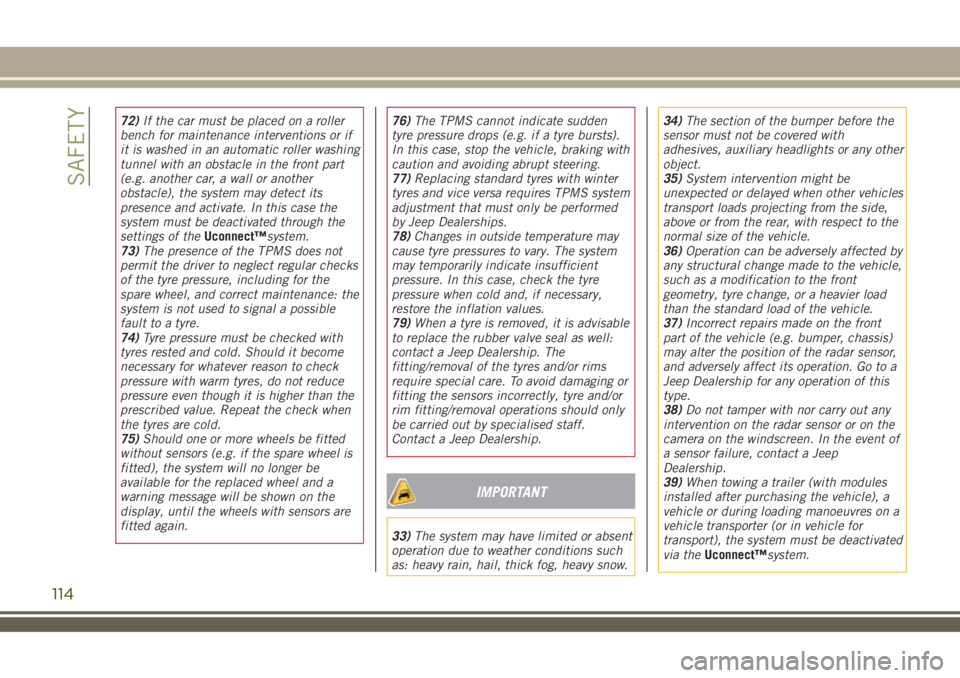
72)If the car must be placed on a roller
bench for maintenance interventions or if
it is washed in an automatic roller washing
tunnel with an obstacle in the front part
(e.g. another car, a wall or another
obstacle), the system may detect its
presence and activate. In this case the
system must be deactivated through the
settings of theUconnect™system.
73)The presence of the TPMS does not
permit the driver to neglect regular checks
of the tyre pressure, including for the
spare wheel, and correct maintenance: the
system is not used to signal a possible
fault to a tyre.
74)Tyre pressure must be checked with
tyres rested and cold. Should it become
necessary for whatever reason to check
pressure with warm tyres, do not reduce
pressure even though it is higher than the
prescribed value. Repeat the check when
the tyres are cold.
75)Should one or more wheels be fitted
without sensors (e.g. if the spare wheel is
fitted), the system will no longer be
available for the replaced wheel and a
warning message will be shown on the
display, until the wheels with sensors are
fitted again.76)The TPMS cannot indicate sudden
tyre pressure drops (e.g. if a tyre bursts).
In this case, stop the vehicle, braking with
caution and avoiding abrupt steering.
77)Replacing standard tyres with winter
tyres and vice versa requires TPMS system
adjustment that must only be performed
by Jeep Dealerships.
78)Changes in outside temperature may
cause tyre pressures to vary. The system
may temporarily indicate insufficient
pressure. In this case, check the tyre
pressure when cold and, if necessary,
restore the inflation values.
79)When a tyre is removed, it is advisable
to replace the rubber valve seal as well:
contact a Jeep Dealership. The
fitting/removal of the tyres and/or rims
require special care. To avoid damaging or
fitting the sensors incorrectly, tyre and/or
rim fitting/removal operations should only
be carried out by specialised staff.
Contact a Jeep Dealership.
IMPORTANT
33)The system may have limited or absent
operation due to weather conditions such
as: heavy rain, hail, thick fog, heavy snow.34)The section of the bumper before the
sensor must not be covered with
adhesives, auxiliary headlights or any other
object.
35)System intervention might be
unexpected or delayed when other vehicles
transport loads projecting from the side,
above or from the rear, with respect to the
normal size of the vehicle.
36)Operation can be adversely affected by
any structural change made to the vehicle,
such as a modification to the front
geometry, tyre change, or a heavier load
than the standard load of the vehicle.
37)Incorrect repairs made on the front
part of the vehicle (e.g. bumper, chassis)
may alter the position of the radar sensor,
and adversely affect its operation. Go to a
Jeep Dealership for any operation of this
type.
38)Do not tamper with nor carry out any
intervention on the radar sensor or on the
camera on the windscreen. In the event of
a sensor failure, contact a Jeep
Dealership.
39)When towing a trailer (with modules
installed after purchasing the vehicle), a
vehicle or during loading manoeuvres on a
vehicle transporter (or in vehicle for
transport), the system must be deactivated
via theUconnect™system.
114
SAFETY